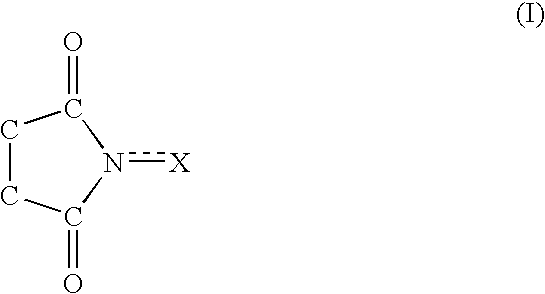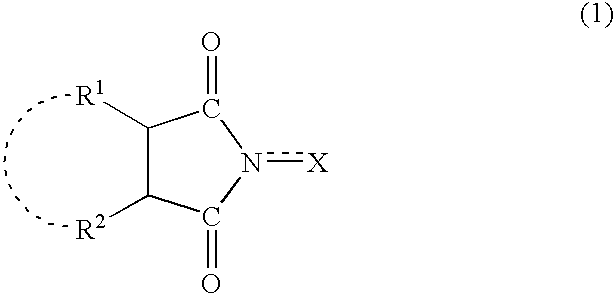Process for producing dicarboxylic acids
a dicarboxylic acid and process technology, applied in the field of process for producing dicarboxylic acid, can solve the problem of significant affecting the space time yield of the resulting dicarboxylic acid, and achieve the effect of high space time yield
- Summary
- Abstract
- Description
- Claims
- Application Information
AI Technical Summary
Benefits of technology
Problems solved by technology
Method used
Image
Examples
example 1
[0086] In a 316 stainless steel reactor having an internal volume of 300 ml, 26 g (309 mmol) of cyclohexane, 14 g of acetic acid, 100.9 mg (0.618 mmol) of N-hydroxyphthalimide, 76. 9 mg (0. 309 mmol) of cobalt(II) acetate tetrahydrate, and 110 mg (0.309 mmol) of bis (acetylacetonato) cobalt (II) were placed, and the reactor was sealed and was pressurized to 50 Kg / cm.sup.2 (4.9 MPa) with a gaseous mixture comprising 50% Of O.sub.2 and 50% of N.sub.2. The liquid temperature was raised on an oil bath and was held at 110.degree. C. Immediately after the liquid temperature reached 110.degree. C., absorption of the gas began. The reaction was terminated by cooling 20 minutes later. A reaction mixture was diluted with 60 g of acetic acid to thereby dissolve all of solid matters. The resulting solution was analyzed to find that a conversion from cyclohexane was 24.4% and a selectivity for adipic acid was 56.1%. In addition, glutaric acid (selectivity: 14.3%), succinic acid (selectivity: 12....
example 2
[0087] In a 316 stainless steel reactor having an internal volume of 300 ml, 18 g (214 mmol) of cyclohexane, 22 g of acetic acid, 69.7 mg (0.428 mmol) of N-hydroxyphthalimide, 53.3 mg (0.214 mmol) of cobalt (II) acetate tetrahydrate, and 76.2 mg (0.214 mmol) of tris(acetylacetonato)co-balt(III) were placed, and the reactor was sealed and was pressurized to 50 Kg / cm.sup.2 (4.9 MPa) with a gaseous mixture comprising 50% of O.sub.2 and 50% of N.sub.2. The liquid temperature was raised on an oil bath and was held at 110.degree. C. Immediately after the liquid temperature reached 110.degree. C., absorption of the gas began. The reaction was terminated by cooling 20 minutes later. A reaction mixture was diluted with 60 g of acetic acid to thereby dissolve all of solid matters. The resulting solution was analyzed to find that a conversion from cyclohexane was 64.8% and a selectivity for adipic acid was 71.6%. In addition, glutaric acid (selectivity: 13.0%), succinic acid (selectivity: 12.5...
example 3
[0088] In a 316 stainless steel reactor having an internal volume of 300 ml, 36 g (428 mmol) of cyclohexane, 4 g of acetic acid, 139.7 mg (0.856 mmol) of N-hydroxyphthalimide, 106.6 mg (0.428 mmol) of cobalt (II) acetate tetrahydrate, and 152.5 mg (0.428 mmol) of tris(acetylacetonato)cobalt(III) were placed, and the reactor was sealed and was pressurized to 50 Kg / cm.sup.2 (4.9 MPa) with a gaseous mixture comprising 50% of O.sub.2 and 50% of N.sub.2. The liquid temperature was raised on an oil bath and was held at 110.degree. C. Immediately after the liquid temperature reached 110.degree. C., absorption of the gas began. The reaction was terminated by cooling 20 minutes later. A reaction mixture was diluted with 60 g of acetic acid to thereby dissolve all of solid matters. The resulting solution was analyzed to find that a conversion from cyclohexane was 8.3% and a selectivity for adipic acid was 36.4%. In addition, glutaric acid (selectivity: 10.4%), succinic acid (selectivity: 7.7%...
PUM
| Property | Measurement | Unit |
|---|---|---|
| temperature | aaaaa | aaaaa |
| pressure | aaaaa | aaaaa |
| pressure | aaaaa | aaaaa |
Abstract
Description
Claims
Application Information
 Login to View More
Login to View More - R&D
- Intellectual Property
- Life Sciences
- Materials
- Tech Scout
- Unparalleled Data Quality
- Higher Quality Content
- 60% Fewer Hallucinations
Browse by: Latest US Patents, China's latest patents, Technical Efficacy Thesaurus, Application Domain, Technology Topic, Popular Technical Reports.
© 2025 PatSnap. All rights reserved.Legal|Privacy policy|Modern Slavery Act Transparency Statement|Sitemap|About US| Contact US: help@patsnap.com



